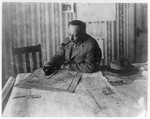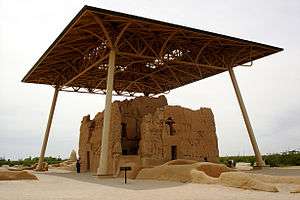Frederick Law Olmsted, Jr.
| Frederick Law Olmsted, Jr | |
|---|---|
 | |
| Born |
July 24, 1870 Staten Island, New York |
| Died |
December 25, 1957 (aged 87)[1] Malibu, California[2] |
| Nationality | American |
| Occupation | Architect |
| Parent(s) |
Frederick Law Olmstead Mary Cleveland Perkins |
| Awards | Pugsley Medal (1953) |
| Practice | Olmsted Brothers |
| Buildings | Biltmore Estate |
| Projects | Washington, D.C.: National Mall; Jefferson Memorial; White House grounds; Rock Creek Park. Others: Bok Tower Gardens; Forest Hills Gardens; Lake Wales, Florida |
Frederick Law Olmsted, Jr. (July 24, 1870 – December 25, 1957) was an American landscape architect who is best known for his wildlife conservation efforts. He had a lifetime commitment to national parks, and worked on projects in Acadia, the Everglades and Yosemite National Park. Olmsted Point in Yosemite and Olmsted Island at Great Falls of the Potomac River in Maryland are named after him. He was the son of Frederick Law Olmsted, Sr., and he and his brother John C. Olmsted created Olmsted Brothers as a successor firm to their father's.
Career
Olmsted was born on Staten Island, New York, the son of Frederick Law Olmsted and Mary Cleveland Perkins, and half brother of John Charles Olmsted.
After graduating from the Roxbury Latin School in 1890,[3] he began his career as his famous father's apprentice. He worked early on two significant projects: the 1893 World's Columbian Exposition in Chicago, and the largest privately owned home in the United States—the George Vanderbilt estate in North Carolina, famously called the Biltmore Estate.
He entered Harvard College where he earned his bachelor's degree in 1894. He then became a partner in his father's Brookline, Massachusetts landscape architecture firm in 1895. Shortly thereafter, his father retired. Olmsted and his half brother quickly took over leadership of the firm. For the next half-century, the Olmsted brothers' firm completed thousands of landscape projects nationwide.
In 1900 Olmsted returned to Harvard to teach, and he also established the school's first formal training program in landscape architecture.
In 1901, he was appointed by President Theodore Roosevelt as a member of the Senate Park Improvement Commission for the District of Columbia, commonly known as the McMillan Commission. He joined other notable personalities such as Daniel H. Burnham, Charles F. McKim and Augustus Saint-Gaudens, with a charge to "restore and develop the century-old plans of Major L’Enfant for Washington and to fit them to the conditions of today."
In 1910, he was approached by the American Civic Association for advice on the creation of a new bureau of national parks. This initiated six years of correspondence, including this letter to the president of the Appalachian Mountain Club, January 19, 1912:
"The present situation in regard to the national parks is very bad. They have been created one at a time by acts of Congress which have not defined at all clearly the purposes for which the lands were to be set apart, nor provided any orderly or efficient means of safeguarding the parks . . . I have made at different times two suggestions, one of which was . . . a definition of the purposes for which the national parks and monuments are to be administered by the Bureau."
His best contribution was of a few simple words that would guide conservation in America for generations to come and were preserved in the National Park Service Organic Act (1916):
"To conserve the scenery and the natural and historic objects and the wild life therein and to provide for the enjoyment of the same in such manner and by such means as will leave them unimpaired for the enjoyment of future generations."
Olmsted and his wife, Sarah Hall Sharples, whom he married on March 30, 1911, had one child.
By 1920, his better-known projects included plans for metropolitan park systems and greenways across the country. In 1928, while working for the California State Park Commission (now part of the California Department of Parks and Recreation), Olmsted completed a statewide survey of potential park lands that defined basic long-range goals and provided guidance for the acquisition and development of state parks.[4] and was a founding member and later president of the American Society of Landscape Architects.

Under the leadership of John Charles Olmsted and Frederick Law Olmsted, Jr., the Olmsted Brothers firm employed nearly 60 staff at its peak in the early 1930s. As the last surviving family member in the firm, Olmsted, Jr. retired in 1949.
A partial listing of Olmsted, Jr. design projects in the nation's capital reads like a guide to National Park Service-managed sites: the National Mall, Jefferson Memorial, White House grounds, and Rock Creek Park. Olmsted also prepared the plan for Boston's metropolitan park system and a master plan for Cornell University, and was involved in the planning of Forest Hills Gardens, Queens, and Roland Park, Baltimore. He was a founding member of the American Society of Landscape Architects and actively involved in numerous planning and design organizations and commissions, including the U.S. Commission of Fine Arts, the National Capital Park and Planning Commission, the Baltimore Park Commission, the National Park Service Board of Advisers for Yosemite, the National Conference on City Planning, the American City Planning Institute, the National Institute of Arts and Letters, and the American Academy in Rome. Olmsted received many awards and honors during his long career, among them the American Academy Gold Medal (1949) and the U.S. Department of the Interior Conservation Award (1956).[5]
In his later years, Olmsted, Jr., worked for the protection of California's coastal redwoods. Redwood National Park's Olmsted Grove was dedicated to him in 1953, the same year in which he received the Pugsley Gold Medal.
He was responsible for the original terrace-style 'master plan' layout of Cornell University, that is responsible for the large Arts Quad and Libe Slope. He also worked on the Bok Tower Gardens in Lake Wales, Florida and Forest Hills Gardens in New York.
Olmsted, Jr. died while visiting friends in Malibu, California[2] and is buried at Old North Cemetery in Hartford, Connecticut.
Projects
- Landscape design at Waveny Park,[6] New Canaan, Connecticut, 1912.
- Shelter at Casa Grande Ruins National Monument, 1932

- St. Francis Wood residential neighborhood located in southwestern San Francisco, California, ci 1914
- Fort Tryon Park, New York City, 1917-1935
- Palos Verdes Estates, Los Angeles County, mid-1930s
- Governor Francis Farms neighborhood founded in 1838 in Warwick, Rhode Island. He designed many of the homes in that neighborhood in 1949.
References
- ↑ American Council of Learned Societies (1958). Dictionary of American Biography. Scribner. p. 485. ISBN 0-684-16226-1.
- 1 2 "The Lasting Legacy of Frederick Law Olmsted, Jr. Is Everywhere". 2008-11-18. Retrieved 2009-02-09.
- ↑ F. Washington Jarvis, Schola Illustris: The Roxbury Latin School, 1645-1995, p. 344. Boston: David R. Godine, 1995. ISBN 1-56792-066-7.
- ↑ "A State Park System is Born". State of California. Retrieved 2007-07-28.
- ↑ Thomas E. Luebke, ed., Civic Art: A Centennial History of the U.S. Commission of Fine Arts (Washington, D.C.: U.S. Commission of Fine Arts, 2013): Appendix B, p. 551.
- ↑ Kendall, Jane. "The Magic of Waveny". Retrieved 2009-02-09.
- M. Christine Boyer, Manhattan Manners: Architecture and Style, 1850-1900. New York: Rizzoli, 1985. ISBN 0-8478-0650-2
![]() This article incorporates public domain material from the United States Government document "http://www.nps.gov/history/history/online_books/sontag/olmsted.htm National Park Service Biography: Frederick Law Olmsted, Jr.". Accessed: 2007-09-13
This article incorporates public domain material from the United States Government document "http://www.nps.gov/history/history/online_books/sontag/olmsted.htm National Park Service Biography: Frederick Law Olmsted, Jr.". Accessed: 2007-09-13
![]() This article incorporates public domain material from the United States Government document "http://www.nps.gov/archive/frla/background.htm Frederick Law Olmsted National Historic Site". Accessed: 2007-09-13
This article incorporates public domain material from the United States Government document "http://www.nps.gov/archive/frla/background.htm Frederick Law Olmsted National Historic Site". Accessed: 2007-09-13
External links
| Wikisource has original works written by or about: Frederick Law Olmsted (1870-1957) |
- www.olmsted.org
- FAQ: Frederick Law Olmsted, Jr.
- {{Internet Archive author |search=( ("Frederick Law Olmsted" OR "Olmsted, Frederick Law") AND -creator:1822)
|